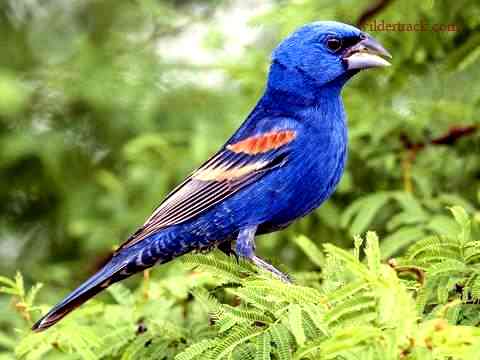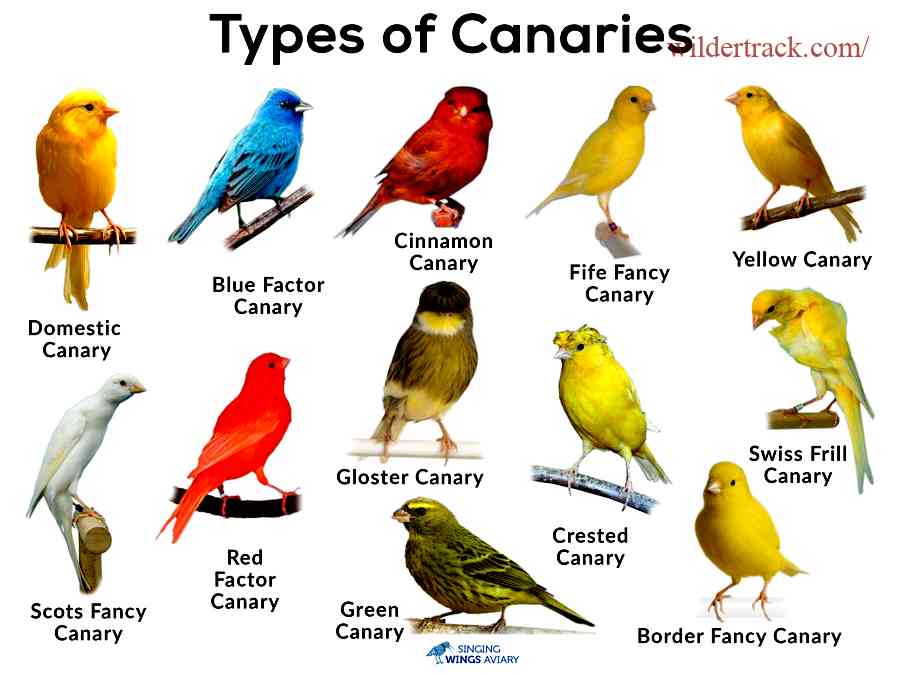Blue factor canaries are a highly sought-after breed of canary known for their beautiful blue hues and melodious singing. These birds, also known as “blue canaries,” have been selectively bred for generations to bring out their distinctive blue coloring. With their stunning appearance and delightful songs, it’s no wonder that blue factor canaries have become a beloved pet for bird enthusiasts around the world. In this article, we’ll explore the origins and characteristics of these fascinating birds and provide tips for caring for your own blue factor canary.
Blue Factor Canary is one of the most intriguing and beautiful canary breeds that is highly sought after by bird enthusiasts all over the world. The bird’s vibrant blue color, coupled with a melodious singing voice, draws many bird watchers to it.
Many breeders breed the Blue Factor Canary for its many desirable traits, and it is considered one of the most successful hybrids of the canary species, with a distinct appearance that sets it apart from other birds.
Overview of Blue Factor Canary

The Blue Factor Canary is a variety of canary that is bred in captivity by selective breeding. It is a hybrid produced by crossing a male black-hooded Siskin with a yellow canary. The unique appearance of the Blue Factor Canary is due to the presence of a blue pigment called Aventurine.
The canary’s song is one of its most beautiful traits, and the Blue Factor Canary’s song is no exception. It has a melodious and sweet voice that is highly sought after by bird lovers and breeders.
The Blue Factor Canary is a medium-sized bird, with a weight of 20-25 grams and a length of about 12 cm. It is a hardy bird that is easy to care for, making it an excellent pet for bird lovers of all experience levels.
History and Origin
The Blue Factor Canary was developed in the early 20th century in France and Belgium, where breeders were trying to develop a new and unique canary breed. They crossed a male black-hooded Siskin with a yellow canary to create a bird that had the beautiful blue color of the Siskin.
The new breed was initially known as the Green-backed Canary due to its greenish-blue color. However, over the years, the breed was refined and developed into the Blue Factor Canary that we know today.
Today, the Blue Factor Canary is a highly sought-after breed that is bred all over the world. It is popular with both bird enthusiasts and breeders who are looking for a bird with unique traits and beauty.
In conclusion, the Blue Factor Canary is a unique and beautiful bird that is highly prized by bird enthusiasts and breeders all over the world. With its vibrant blue color and sweet singing voice, the Blue Factor Canary is a treat for the eyes and ears. Its history and origin make it a fascinating breed that has been refined over many years to achieve its current level of excellence.
Appearance and Characteristics

The Blue Factor Canary is an elegant, medium-sized bird with a distinctive blue-gray coloration that sets it apart from other common types of canaries.
One of the most visually striking features of this bird is its head, which is characterized by a flattened appearance and a short, curved beak. The Blue Factor Canary also boasts an elegant fan- shaped tail that is set high and wide. Other notable physical features include a soft, fluffy plumage and bright, expressive eyes that are set apart by thin, black lines.
In terms of behavioral traits, these birds are known for their lively and energetic personalities. They are highly active, constantly flitting about their cages or aviaries and chirping with excitement. These vibrant little birds are also quite intelligent and curious, and they are always eager to explore their surroundings and interact with anyone who happens to be nearby.
Physical Features
The Blue Factor Canary is prized for its unique coloration and striking physical appearance. These birds typically measure around 4.5 inches in length and weigh between 0.5 to 1 ounce, making them just the right size for a lovely household pet. They have a clear, blue-gray coloration that is distinct and eye-catching.
Another unique feature of the Blue Factor Canary is its head shape. As mentioned earlier, these birds have a flattened appearance at the top of their heads, which gives them a distinctive and memorable look. They also feature a short, curved beak that is perfect for breaking up the seeds and other foods that make up their diet.
Additionally, the fan-shaped tail of a Blue Factor Canary is set high and wide and is comprised of evenly spaced, feathered strands that create a visually stunning effect that is sure to impress any bird enthusiast.
Behavioral Traits
Perhaps the most endearing characteristic of the Blue Factor Canary is its vibrant and energetic personality. These birds are known for their lively and animated behavior, and they are constantly chirping and flitting about their cages or aviaries with excitement and enthusiasm.
In addition to their active demeanor, Blue Factor Canaries are also highly intelligent and curious creatures. They are naturally inquisitive and have a natural inclination to explore their surroundings and interact with their human caretakers. As such, they make excellent pets for both experienced bird owners and those who are new to keeping birds.
Overall, the Blue Factor Canary is a unique and visually striking bird that is sure to please anyone who values beauty and personality in their pets. Whether you are an experienced bird owner or simply looking for a new, engaging companion, the Blue Factor Canary is sure to provide you with a lifetime of joy and companionship. Don’t hesitate to add one of these lovely birds to your household today! And remember, when looking for a pet bird, the blue factor canary is a fantastic choice for those seeking an energetic, vibrant, and intelligent bird.
Housing and Environment

As a responsible pet owner, it is important to provide a comfortable and suitable environment for your pets. When it comes to blue factor canaries, their housing needs can vary depending on their size and behavior. Ideally, a cage that is at least 18 inches long, 12 inches wide, and 18 inches high is suitable for a single blue factor canary.
When selecting a cage, it is important to choose one that is made of safe, non-toxic materials, with a solid floor and bars spaced no more than 1/2 inch apart. The cage should also have plenty of perches made of natural wood, with different diameters to help exercise the birds’ feet. In addition, it is important to provide a variety of toys and accessories to keep the birds mentally stimulated and entertained.
The placement of the cage is also crucial to the birds’ well-being. Blue factor canaries thrive in a quiet environment away from loud noises and direct sunlight. They also require adequate ventilation and a consistent, comfortable temperature. The ideal temperature for these birds is between 68 and 78 degrees Fahrenheit.
Cage Size and Type
The size and type of cage you choose for your blue factor canary is one of the most important factors in their overall health and well-being. As mentioned earlier, a cage that is at least 18 inches long, 12 inches wide, and 18 inches high is a suitable size for a single bird. However, if you plan on keeping multiple birds, you will need to increase the size of the cage accordingly.
When it comes to the type of cage, many experts recommend choosing a wrought-iron or powder-coated steel cage. These materials are durable, safe, and easy to clean. Additionally, they can withstand the birds’ beaks and claws without being damaged.
Lighting and Temperature
Lighting and temperature are two key factors in the health and happiness of your blue factor canary. A consistent schedule of daylight and darkness is crucial for their circadian rhythms and overall well-being. If you do not have access to natural sunlight, you can use artificial lighting to mimic the natural light cycle.
As mentioned earlier, the ideal temperature for blue factor canaries is between 68 and 78 degrees Fahrenheit. It is important to keep the cage away from direct sunlight, drafts, and extreme temperature changes. You can also use a small heater or air conditioner to maintain a consistent temperature as needed.
Nutrition and Feeding
A healthy and balanced diet is essential for the longevity and well-being of your blue factor canary. These birds require a variety of foods, including seeds, fruits, and vegetables. Make sure to provide a quality seed mix that includes a variety of seeds such as millet, canary grass, and rapeseed. You can also provide fresh fruits and vegetables such as apples, carrots, and broccoli.
It is important to avoid feeding your birds avocados, chocolate, caffeine, and alcohol as these can be toxic to birds. Additionally, clean and fresh water should be available at all times.
In conclusion, providing a comfortable and suitable environment for your blue factor canary is crucial for their overall health and well-being. This includes choosing the appropriate size and type of cage, maintaining adequate lighting and temperature, and providing a healthy and balanced diet. By following these guidelines and providing plenty of love and attention, your blue factor canary can live a long and happy life.
Breeding and Reproduction
Breeding and reproduction are essential factors in maintaining a healthy and diverse population of blue factor canaries. There are several important considerations when it comes to breeding and ensuring the successful reproduction of these birds.
One of the most critical elements of breeding is ensuring that the breeding birds are healthy and well-fed. This means providing them with a high-quality diet that is rich in protein and plenty of fresh water. It is also important to make sure that the birds have ample space to move around, and that they are kept in clean and comfortable conditions.
When it comes to breeding blue factor canaries, there are a few different approaches you can take. One option is to pair a male and female together in a breeding cage. This allows them to mate and produce offspring without interference from other birds.
Another option is to use a process known as selective breeding, where you carefully choose which birds to breed based on their genetic traits. This method allows you to produce offspring with specific desirable traits, such as a beautiful blue color or a strong singing voice.
Regardless of the breeding method you choose, it is essential to pay close attention to the birds’ behavior and health. This can help you identify any potential problems or diseases early on, ensuring that your blue factor canaries remain healthy and strong.
Mating and Pairing
Mating and pairing are critical components of the breeding and reproduction process for blue factor canaries. When it comes to breeding these birds, it is important to understand the best strategies for mating and pairing to ensure that the process is successful.
One approach is to pair compatible birds together based on their personalities and behavior. This can help ensure that the birds are comfortable with each other and more likely to mate successfully. It is also important to make sure that you are pairing a male and female bird together, as this is the only way they can reproduce.
Another important factor to consider when it comes to mating and pairing blue factor canaries is timing. These birds typically breed during the spring and summer months when the days are longer and the weather is warmer. It is essential to provide your birds with plenty of natural light and a comfortable environment during this time to encourage successful mating.
Once the birds have mated, it is important to separate the female from the male to prevent aggression towards the eggs. The female will then incubate the eggs for around 14-16 days, after which they will hatch into adorable, fluffy chicks.
Incubation and Hatching
Incubation and hatching are critical stages in the breeding process for blue factor canaries. It is essential to provide the right environment and conditions to ensure successful incubation and a healthy hatching process.
The ideal temperature for incubation is between 37.5 and 38.3 degrees Celsius, with a humidity level of around 60%. It is essential to maintain these conditions throughout the incubation process to ensure that the eggs develop properly.
During the incubation process, it is also important to make sure that the eggs are turned regularly to prevent them from sticking to the shell. This can be done manually or with an automatic egg turner, which ensures that the eggs are rotated regularly to prevent any deformities in the chicks.
Once the eggs have hatched, it is essential to provide the chicks with a warm and safe environment. This means providing them with a clean and comfortable nest box, as well as plenty of food and water. It is also important to make sure that the temperature in the nest box is maintained at around 32 degrees Celsius to ensure that the chicks stay warm and healthy.
In conclusion, breeding and reproduction are essential factors in maintaining the health and diversity of blue factor canaries. With the right approach to mating, pairing, incubation, and hatching, you can successfully produce healthy and happy blue factor canaries that will brighten up any avian collection. Remember to keep an eye on your birds’ behavior and health throughout the breeding process, and you’ll be rewarded with a successful and rewarding breeding experience.
Health and Care

When it comes to the health and care of your pet, there are a lot of things you need to consider. From keeping up on their vaccinations to watching for any signs of illness, taking care of a pet can be a big responsibility. One of the best ways to ensure that your pet stays healthy is by providing them with a well-balanced diet. This can be achieved by offering a variety of different foods, including fresh fruits and vegetables, high-quality proteins, and whole grains. In addition to feeding them a healthy diet, it’s important to encourage physical activity and exercise. This can help keep your pet at a healthy weight and reduce the risk of other health issues.
Disease Prevention
Preventing diseases in your pet is essential for their overall health and wellbeing. One of the most important things you can do to prevent disease is to keep up on their vaccinations. Vaccinations protect your pet from a variety of potentially deadly diseases, including rabies, distemper, and parvo. It’s also important to keep your pet’s environment clean and free from germs and bacteria. Regular grooming can help keep your pet’s skin and coat healthy, as well as reducing the risk of fleas and ticks.
Common Health Issues
While prevention is key when it comes to maintaining your pet’s health, it’s important to be aware of common health issues that can affect them. One of the most common health issues in birds is respiratory infections. Symptoms of a respiratory infection can include sneezing, coughing, and difficulty breathing. Another common issue is digestive problems, which can be caused by an imbalanced diet or an underlying health condition. If your pet is experiencing any health issues, it’s important to seek veterinary care as soon as possible.
Veterinary Care
Regular veterinary care is an important part of keeping your pet healthy. Your veterinarian can help you develop a preventative care plan, as well as diagnose and treat any health issues that arise. Some of the services that your veterinarian may offer include wellness exams, vaccinations, blood work, and dental care. If you’re in need of veterinary care for your pet, be sure to choose a reputable and experienced veterinarian. They should be able to provide your pet with the care they need to stay healthy and happy.
In conclusion, taking care of your pet’s health and wellbeing is a big responsibility. By providing them with a healthy diet, encouraging exercise, and seeking veterinary care when needed, you can help ensure that they live a long and healthy life. Don’t forget to watch for any signs of illness, and seek veterinary care immediately if you suspect that your pet is sick. With the proper care and attention, your blue factor canary can thrive and enjoy a happy life.
When it comes to raising and caring for a blue factor canary, it is important to keep in mind that these stunning birds require a lot of time, attention, and care to thrive in captivity. From ensuring they have a healthy diet to providing them with a spacious and stimulating environment, there are plenty of steps you can take to ensure your blue factor canary lives a happy and healthy life.
One key aspect of caring for a blue factor canary is to pay close attention to their diet. These birds require a varied and balanced diet that includes a mix of seeds, fresh fruits and vegetables, and even live food like insects or mealworms. It is important to avoid feeding them strictly seeds or processed foods, as this can lead to malnutrition and health problems over time.
Another important aspect of caring for a blue factor canary is to provide them with a spacious and stimulating environment. These birds are active and social creatures that thrive when they have plenty of room to fly, explore, and interact with their surroundings. You should aim to provide your canary with a cage or aviary that is at least two feet long, with plenty of perches and toys to keep them entertained.
Overall, raising and caring for a blue factor canary can be a rewarding experience for dedicated bird owners. By taking the time to provide them with proper nutrition, space, and attention, you can ensure that your blue factor canary lives a happy and healthy life in captivity.
Summary
To summarize, blue factor canaries are beautiful and unique birds that require a lot of care and attention to thrive in captivity. When caring for these birds, it is important to focus on providing them with a balanced and varied diet, as well as a spacious and stimulating environment.
In terms of diet, blue factor canaries require a mix of seeds, fresh fruits and vegetables, and live food to ensure they receive all the necessary nutrients. It is also important to avoid feeding them strictly seeds or processed foods, as this can lead to health problems over time.
When it comes to their environment, blue factor canaries need plenty of space to fly, explore, and interact with their surroundings. You should aim to provide them with a cage or aviary that is at least two feet long, with plenty of perches and toys to keep them entertained.
By taking these steps, you can provide your blue factor canary with the proper care and attention they need to live a happy and healthy life in captivity.
Tips for Successful Raising and Caring of Blue Factor Canary
If you are looking to raise and care for a blue factor canary, there are a few key tips you should keep in mind. These include:
1. Provide a varied and balanced diet: As mentioned, blue factor canaries require a mix of seeds, fresh fruits and vegetables, and live food to ensure they receive all the necessary nutrients.
2. Provide ample space and stimulation: Blue factor canaries are active and social creatures that need plenty of room to fly, explore, and interact with their surroundings. Make sure to provide them with a spacious cage or aviary, along with plenty of perches and toys to keep them entertained.
3. Invest in quality equipment and supplies: When it comes to caring for your blue factor canary, it is important to invest in high-quality cages, toys, and other supplies to ensure their health and safety.
4. Keep their environment clean: Regular cleaning of your blue factor canary’s cage or aviary is essential to prevent the buildup of bacteria and other harmful substances that can impact their health.
5. Provide regular health checks and veterinary care: Finally, it is important to provide your blue factor canary with regular health checks and veterinary care to ensure they stay healthy and happy throughout their life.
By following these tips, you can successfully raise and care for a beautiful and unique blue factor canary. Whether you are a seasoned bird owner or new to the world of aviculture, these birds can make a wonderful addition to any home or collection.
In conclusion, the blue factor canary is a unique bird breed with amazing physical characteristics and singing ability. As a popular pet bird, it requires proper care and nutrition to thrive. Its beautiful blue coloring is a result of specific genetics, making it a sought-after variant in the canary world. Overall, the blue factor canary is a true gem among indoor bird enthusiasts.
